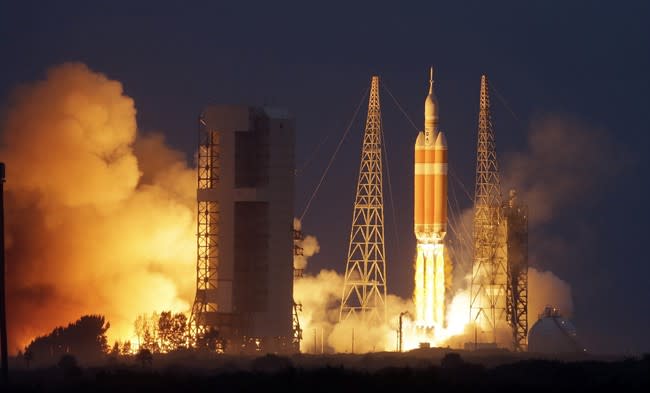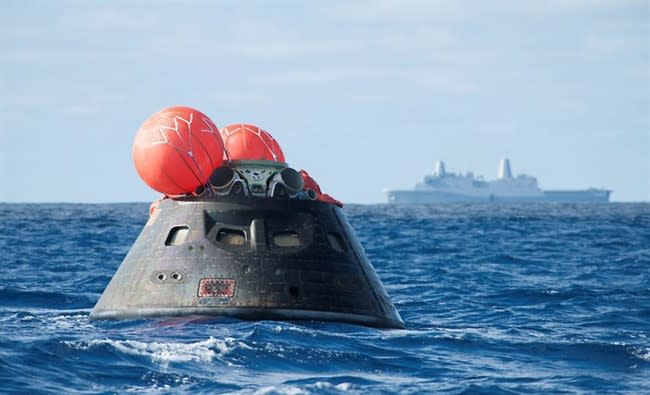2014 Year in Review: Top 10 space stories of the year

In 2014, astronomy and space exploration experienced many spectacular breakthroughs, achievements and even setbacks.
The year saw space agencies attempt to open up new frontiers for private industry and to set the stage for deep space exploration by humans, while robotic ambassadors and giant eyes on the cosmos continued to shed light on some of the deepest mysteries of the universe.
So here’s a recap of our picks for some of the coolest space stories that made a lot of buzz in 2014.
Rosetta Comet Rendezvous and Landing
The most important space achievement of 2014 has to be the Rosetta mission. The comet-hunting spacecraft first made headlines in August when, after sailing through the inner solar system for nearly a decade, it finally met up with Comet 67P/Churyumov-Gerasimenko and parked itself in a tight orbit.
Then on Nov. 12, a tiny oven-sized lander named Philae was released from the mothership, and its seven-hour descent to the surface of the comet captivated millions worldwide. While the landing was the first-ever on a surface of one of these icy visitors – it was not without its own drama. Despite running out of batter power earlier than hoped, it still managed to collect a large amount of data before entering hibernation mode.

Orion Test Flight
NASA's Orion spacecraft – built to take a human crew into deep space including eventually Mars – completed its first nearly flawless unmanned test flight in early December.
Circling the Earth twice, the Apollo-like capsule designed to carry up to 6 astronauts tested out the heat shield and radiation levels inside the craft as it experienced low-Earth orbit and re-entry. Hopes are this will be the first step to a manned mission to an asteroid in the mid 2020s and to Mars in the 2030s.
Private Space Industry Setbacks
In late October, an Orbital Science's unmanned Antares rocket carrying supplies to the space station exploded six seconds after lift-off in Virginia.
Only a few days later, Richard Branson’’s Virgin Galactic's SpaceShipTwo, a craft expected to take tourists to space, crashed during a test flight on the Mojave Desert, killing one pilot and injuring another.
The back-to-back accidents have raised questions about the safety and reliability of commercial spacecrafts. It also has budding space tourists and companies wanting to place their cargo on these rockets asking if it's worth the risk.

Water on Exoplanet
Astronomers in September announced that they had found clear evidence of water on a planet beyond our solar system.
Water vapor was confirmed in the atmosphere of a Neptune-sized world 122 light years from Earth. This discovery also is the first time this basic building block of life as we know it has been identified on a planet so small. The discovery paves the way for the hunt for even smaller planets with oceans and ones that could sustain life.

Methane Burps on Mars
NASA's Curiosity rover detected spikes of methane gas on Mars, which has scientists scratching their heads as to what the root cause may be.
The unexpected findings released in mid-December may point to either a surprising geological activity or may even be the byproduct of microbial life hiding underground. Next-generation rovers and orbiters will be on the case to help identify potential methane hotspots.

Enceladus subsurface ocean
In early April, scientists announced that NASA’s Cassini orbiter detected an ocean on Saturn's moon Enceladus.
The large body of water, estimated to be the size of Lake Superior, lies about 40 to 48 kilometres below the icy crust of the 500-kilometre-wide moon. Also, salty ice geysers and heat have been seen erupting through cracks and fissures in the ice.
This all has researchers excited because it may indicate that this tiny moon’s hidden ocean may offer a potentially habitable environment.

Hubble Reveals Universe's Oldest Galaxies
In January, the Hubble Space Telescope was able to take a peer back at the oldest and most distant galaxies ever seen.
Estimated to be about 13.2 billion light years from Earth, these giant islands of stars appear to have been only a fraction the size of our own Milky Way and were intense star factories, pumping suns out 50 times more frequently than their counterparts today.
With the Universe itself estimated to be 13.7 billion years old, these new glimpses of baby galaxies will help explain not only the birth of the earliest stars but also how our own home galaxy arose.
Mega-Earth - New Class of Planets
A rocky world measuring 17 times the mass of Earth was discovered in June, and now holds the record as the heaviest Earth-like planet ever detected.
Dubbed Kepler 10c, the planet was discovered by its namesake NASA’s planet-hunting space telescope. It orbits a Sun-like star located 560 light years away. This weird discovery has stumped scientists because they expected a planet this size would be a Neptune-like gas giant, but instead it is much more compact and heavy, which means it must be made of rock. As a result, a whole new class of planets may now have to be created. It also raises intriguing possibilities for casting a much wider net in the search for habitable worlds.
Mars Invasion
Mars got a little more crowded this year, as two new orbiting spacecraft set up shop around the Red Planet.
After a ten-month journey, NASA’s Mars Atmosphere and Volative Evolution mission (MAVEN) was the first to enter orbit on Sept. 21. Its mission is to examine the history of the planet’s tenuous atmosphere and help understand what may have caused Mars to go from an Earth-like planet with a thick atmosphere and large bodies of water to the barren, dry world we see today.
Only two weeks later, India’s own Mars Orbiter Mission (MOM) arrived – making India only the third nation to successfully reach Mars. The East Asian country’s spacecraft will not only examine the chemistry of the atmosphere but also the surface chemistry and geology over the next two years.
Zombie spacecraft rescue
Making big waves in social media in July, an abandoned NASA satellite was resuscitated by a bunch of retired NASA engineers and hackers thanks to crowdsource funding.
The International Sun-Earth Explorer (ISEE-3) originally launched back in 1978 to study solar particles thrown off by the Sun and was retired by the space agency in 1997. Flash-forward to 2014 and fans of the spacecraft managed to raise nearly $160,000 to resurrect the hibernating spacecraft in the hopes of taking control of it.
Unfortunately, the team had to give up their efforts to place the satellite in a functional orbit and conduct new projects when it was realized that there was not enough onboard fuel for the thrusters. So the probe simply swung past the moon and back out towards deep space.
While a disappointment, the audacious project still sets a precedence and shows that a private group of people outside of NASA can establish communication with long forgotten, zombie spacecrafts.


